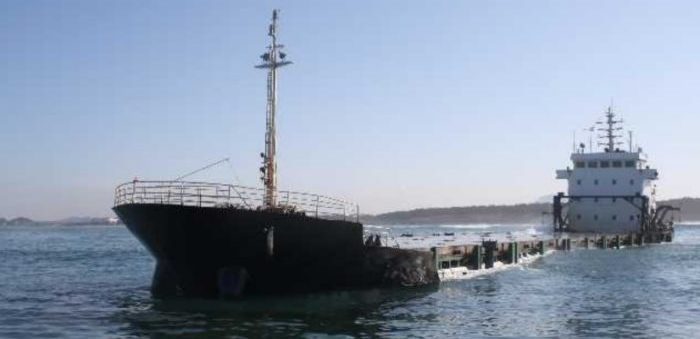In January 2017, the cargo ship ‘Tong Da’ was proceeding east-northeast in Genkai-nada, off the north of Oshima Island, Japan, with 14 crew members onboard, when her hull listed to port and she was intentionally run aground. Tong Da had seawater damage to her engine, cargo, etc. The Japan Transport Safety Board issued an investigation report.
The incident
At around 02:30 on 7 January 2017, the Vessel departed Weifang Port, China, loaded with 4,154.8 tons of sodium chloride, magnesium chloride, and other items for Hachinohe Port, Aomori Prefecture. At around 14:00 on January 9, when the Vessel began proceeding for Kanmon Passage while off southwest of Jeju Island, Republic of Korea, she was subjected to wind and waves coming from her port side and began rolling to port and starboard at about 10° to 20°.
At around 05:00 on January 10, the master arose and came up to the bridge and observed that the Vessel was listing approximately 3° to port. He thought there was flooding in a ballast tank and ordered the chief officer to conduct a sounding of the tank. However, a measurement could not be taken due to the Vessel’s rolling, and thus the master decided to let go anchor and then take the sounding.
At around 19:10, after the Vessel let go anchor off to the northeast of Hiradoshima Island, Nagasaki, the master and the chief officer found that there was no flooding in any ballast tank. When the master next opened the hatch cover of the No. 2 cargo hold to inspect the inside of the hold, he saw that the space between the port-side wall of the No. 2 cargo hold and the cargo had narrowed, and he thought that the hull was listing to port because the cargo in the No. 2 cargo hold had shifted to port. Because the master had had previous experience navigating with a hull list of approximately 3°, he thought he could again safely navigate with a list. Thus, the Vessel weighed anchor at around 02:55 on January 11 and resumed navigating toward Hachinohe Port.
At around 09:00, the master took over the bridge watch from the chief officer and remained on watch with the hull continuing to list approximately 3° to port. However, at around 12:00, he became concerned because the hull was listing approximately 10° and the port stern was sinking, and seawater was washing over the upper deck. He decided to let go anchor and inspect the cargo holds.
At around 14:09, the master let go anchor off to the north of the Ashiyakaigan Coast, Okagaki Town, Fukuoka, and instructed the chief officer to inspect the cargo holds. When the chief officer did so together with an able seaman, he found no abnormalities in the No. 1 cargo hold but observed flooding in the No. 2 cargo hold. The chief officer sent Able Seaman A to call the master and communicated with the chief engineer to ask him to discharge seawater from the No. 2 cargo hold.
The chief engineer received the communication and began discharging water from the No. 2 cargo hold with the bilge pump. When the master checked the situation in the No. 2 cargo hold, he observed that the flooding had reached roughly half the cargo hold’s height. He felt there was a risk of foundering and at around 15:20 decided to intentionally run aground.
At around 15:25, the Vessel weighed anchor and began navigating toward Ashiyakaigan Coast. The master then requested rescue from Japan Coast Guard and ordered the crew to prepare to abandon ship. At around 16:00 the master intentionally ran the Vessel aground on the coast’s sandy beach. All crew members of the Vessel left the Vessel by life raft at around 23:25 and then transferred to the patrol vessel. Subsequently, the Vessel was scrapped.
Probable causes
It is probable that the vessel was listing by approximately 3° after cargo in her No. 2 cargo hold shifted to the port side due to her hull’s rolling. In addition, seawater that was washing up flooded the No. 2 cargo hold because the weathertightness of the upper deck was not being properly maintained and, as a result, the Vessel listed approximately 10° to port.
Actions required The following measures are possible to prevent recurrence of similar accidents: Further details may be found herebelow:


































































